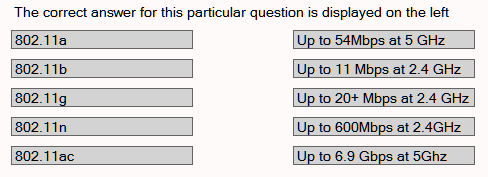Instructions :
1. Different 802.11 standards are given in the column A
2. Various speed ranges of 802.11 standards are given in the column B

3. Match (drag and drop) the standards given on the column A with their speed ranges given on the column B.
Explanation:

The following are the important features of 802.11 standards:
1. IEEE 802.11: Standard for wireless LANs
2. The hardware costs are more for 802.11b compared with 802.11g, and the standard is not yet well established.
3. The 802.11g standard supports data rates up to 54 Mbps, whereas 802.11b supports data rates only up to 11 Mbps.
4. The hardware complying to 802.11g operates at 2.4 GHz range
5. The 802.11g equipment is as susceptible to interference as 802.11b.
6. IEEE 802.11g is compatible with 802.11b, but not compatible with 802.11a, or Bluetooth.
7. 802.11n works in both 2.4GHz, and 5GHz bands. The standard supports up to 600Mbits/sec bandwidths. It is downward compatible with 802.11a, 802.11b, and 802.11g standards.
8. 802.11a, and 802.11g use OFDM (short for Orthogonal Frequency Division Multiplexing). IEEE 802.11b uses DSSS (short for Direct Sequence Spread Spectrum) for encoding.
9. 802.11ac : The emerging Wi-Fi signaling standard, 802.11ac utilizes 5GHz channel. 802.11ac offers backward compatibility to 802.11b/g/n and bandwidth rated up to 6.9 Gbps at 5 GHz band. The speed is theoretical maximum and actual speeds will depend on several factors, like number of antennas, channel bandwidth, etc. For 160MHz channel, the speed is 867 Mbit/s, and 802.11ac can have up to 8 antennas at 160MHz channel, delivering 6.9Gbits/sec speed, theoretically.
The data rates supported by various wireless standards are as given below:
As shown above, Bluetooth has the lowest data rates, whereas 802.11a, and 802.11g support data rates up to 54 Mbps.
Important Points to Remember:
IEEE 802.16 : Wireless Networking - "WiMAX"
Worldwide Interoperability for Microwave Access (WiMAX) is based on 802.16.
IEEE 1905.1-2013: This focuses on an abstraction layer that can allow for multiple home networking technologies to use a common interface. That abstraction layer can then support a dynamic interface capable of transmitting packets arriving from any upper protocol layers or underlying network technologies.
Disclaimer: Simulationexams.com is not affiliated with any certification vendor, and Sim-Ex™ Practice Exams are written independently by SimulationExams.com and not affiliated or authorized by respective certification providers. Sim-Ex™ is a trade mark of SimulationExams.com or entity representing Simulationexams.com.Network+™ is a trademark of CompTIA® organization.